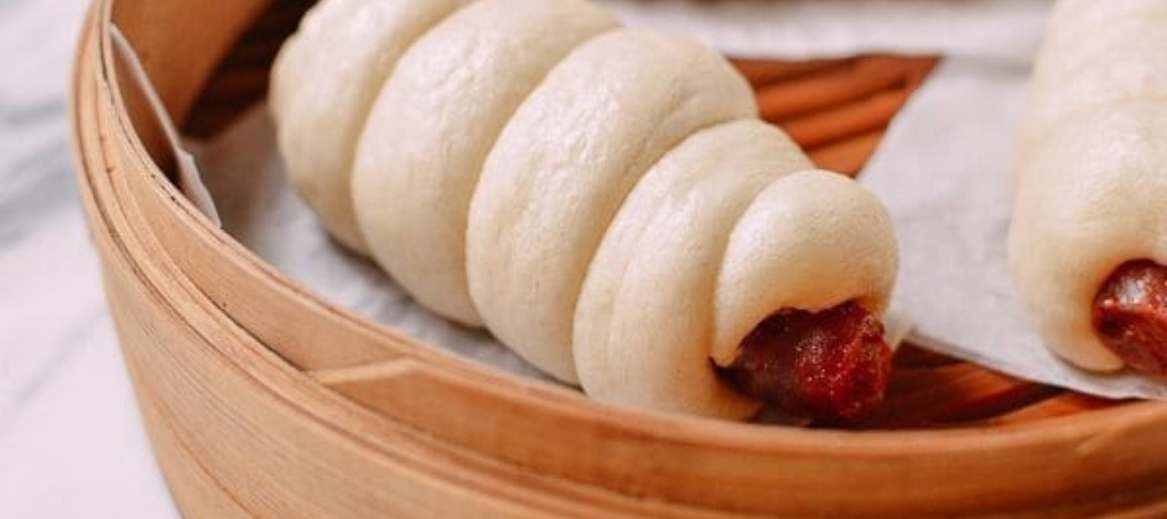CHINESE SAUSAGE IN A BUNS (LOP CHEUNG BAO)
These Lop Cheung Bao (Chinese Sausage Buns) are a wonderful treat from the past that you don’t see very often these days. In each of these Chinese Sausage Buns, you’ll find an irresistibly salty and savory link of cured Chinese sausage—the Chinese Hot Dog Bun’s tasty and authentically Chinese relative.
THIS IS A RARE TREAT.
Dim sum and Chinese bakeries no longer serve Chinese Sausage Buns, a long-time favorite that has waned in popularity in recent years. Because I don’t know why it is too fattening? Is it difficult to keep them fresh at restaurants and bakeries? Are profit margins too low? What’s up with the lop cheung Chinese sausage?
Since these buns have become so hard to get, I’m not sure if the last time I had one may have been when I was a kid in upstate New York.
Not only are Chinese Sausage Buns tasty, but they can also be frozen and reheated easily. Let the steamed buns cool completely before freezing for an on-the-go kid’s snack or dinner. Ten minutes of steaming is needed to bring them out of the freezer.
Fresh from the steamer, we could not believe how long we had waited to reintroduce this old favorite. Get to work on these! You won’t be sorry you spent your childhood with them.
INGREDIENTS:
- 3/4 cup warm water
- 1 tsp. of instant yeast (3g)
- 1 tbsp. of granulated sugar (12g)
- 1 tbsp. of canola oil (plus 1 teaspoon)
- 2 cups of all purpose flour (you can use bleached flour if you like, 272g)
- 2 tbsp. of cornstarch (20g)
- ¼ tsp. of salt (3g)
- 1/8 tsp. of baking soda (1g)
- 10 pcs. Chinese sausages (lop cheung)
INSTRUCTIONS:
- Whisk the water, yeast, and sugar together in a small bowl until the yeast dissolves. When the yeast “blooms” and “foams” in the mixture, it’s ready (about 15 minutes). Let it cool, then add 1 tbsp of the oil and mix well.
- Whisk together the flour, cornstarch, salt, and baking soda, and then add the yeast mixture with a spatula into the medium-sized basin and mix thoroughly. After combining dry and wet ingredients, knead the dough with your hands (or a machine). A tablespoon of flour at a time can be added if the dough is too sticky. Keep kneading until the dough is smooth and soft. The dough should be supple but not goopy or sticky.
- The dough should be wrapped in plastic and covered with a teaspoon of oil. When the dough has doubled in size, it is ready to be baked (about 1 hour).
- Preparation of the steaming equipment or setup can be done while the dough is rising. Using a wok steamer rack or a multi-tiered metal steamer, both of which we use frequently in our kitchen, is one alternative for setting up a steamer. A heatproof dish should be used to steam the lop cheung (Chinese sausages). Allow for cooling to take place.
- You may easily reduce the amount of meat per bun by splitting the buns lengthwise after steaming and cooling them, and using half of a Chinese sausage per bun instead of a whole one, as we did in this recipe.
- Once the dough has finished proving, punch it down and knead it for a few minutes to get rid of all the air bubbles. Shape each ball into a 10-inch-long strip by dividing the dough into 10 equal pieces. Make sure to overlap the dough as you wrap it around each lop cheung. Finish the job by tying up loose ends. Our recipe for Chinese Hot Dog Buns uses the same process.
- A parchment paper rectangle should be made for each bun. Place the parchment paper rectangles in your steamer. To prevent the dough from drying out, cover it with a damp kitchen towel and let it rest for 20 minutes.
- Turn the steamer to high and add the buns with 112 inches of cold water. Turn reduce the heat to medium and continue to steam the buns for another 10 minutes until they’ve risen to their full size.
- Disconnect the steamer from the stovetop and set it aside. Do not remove the steamer lid during the five-minute rest period for the buns. Because the buns will collapse and lose their fluffy structure if you remove the cover too early, this is a critical step!
- Transfer the buns to a serving platter and enjoy them while they’re still warm!
- You can freeze and reheat these Chinese sausage buns with no problem at all! Before freezing the buns, make sure they have been steamed and cooled fully. Steam the frozen buns for around 10 minutes in a steamer to thaw them out.
